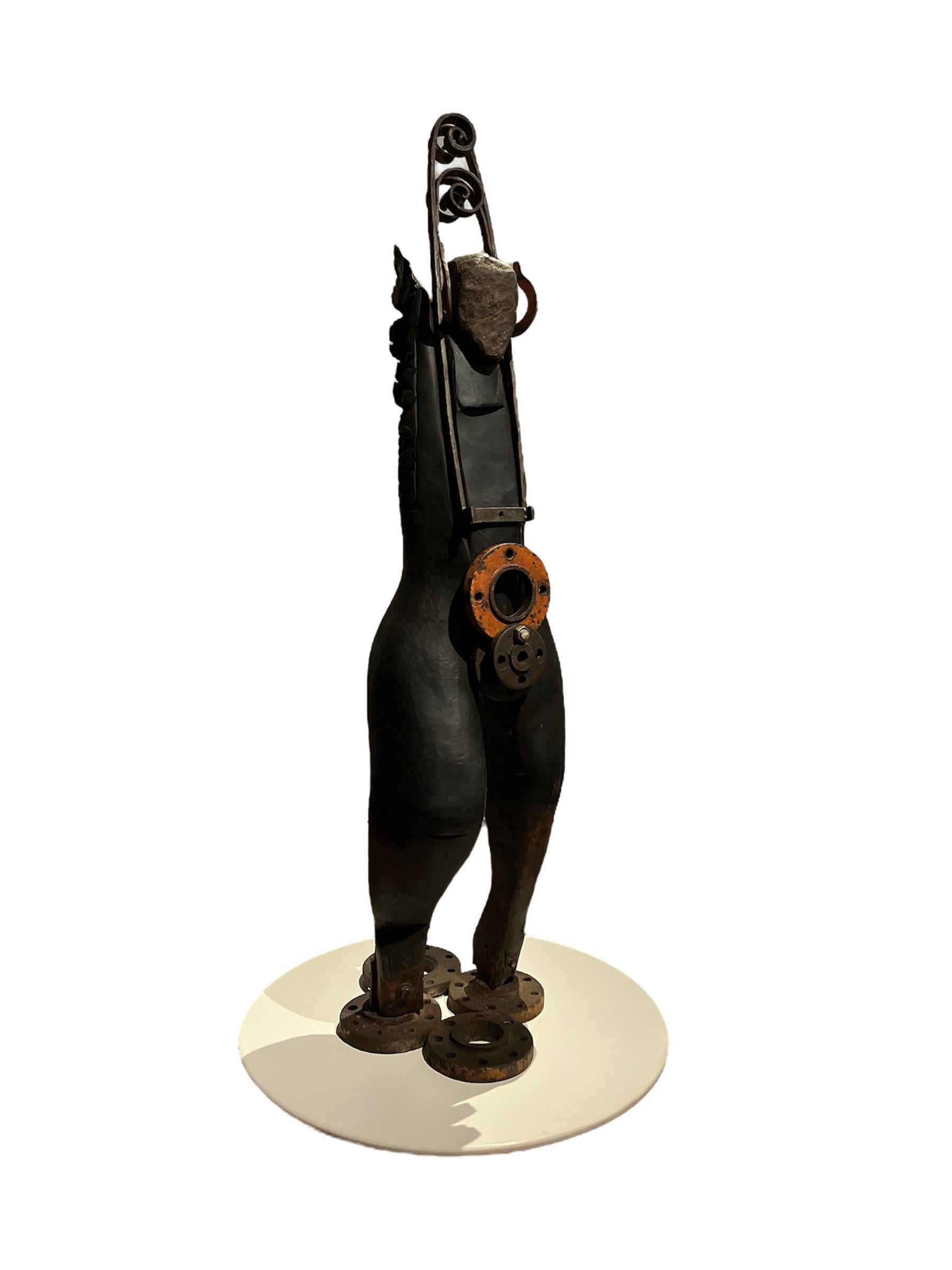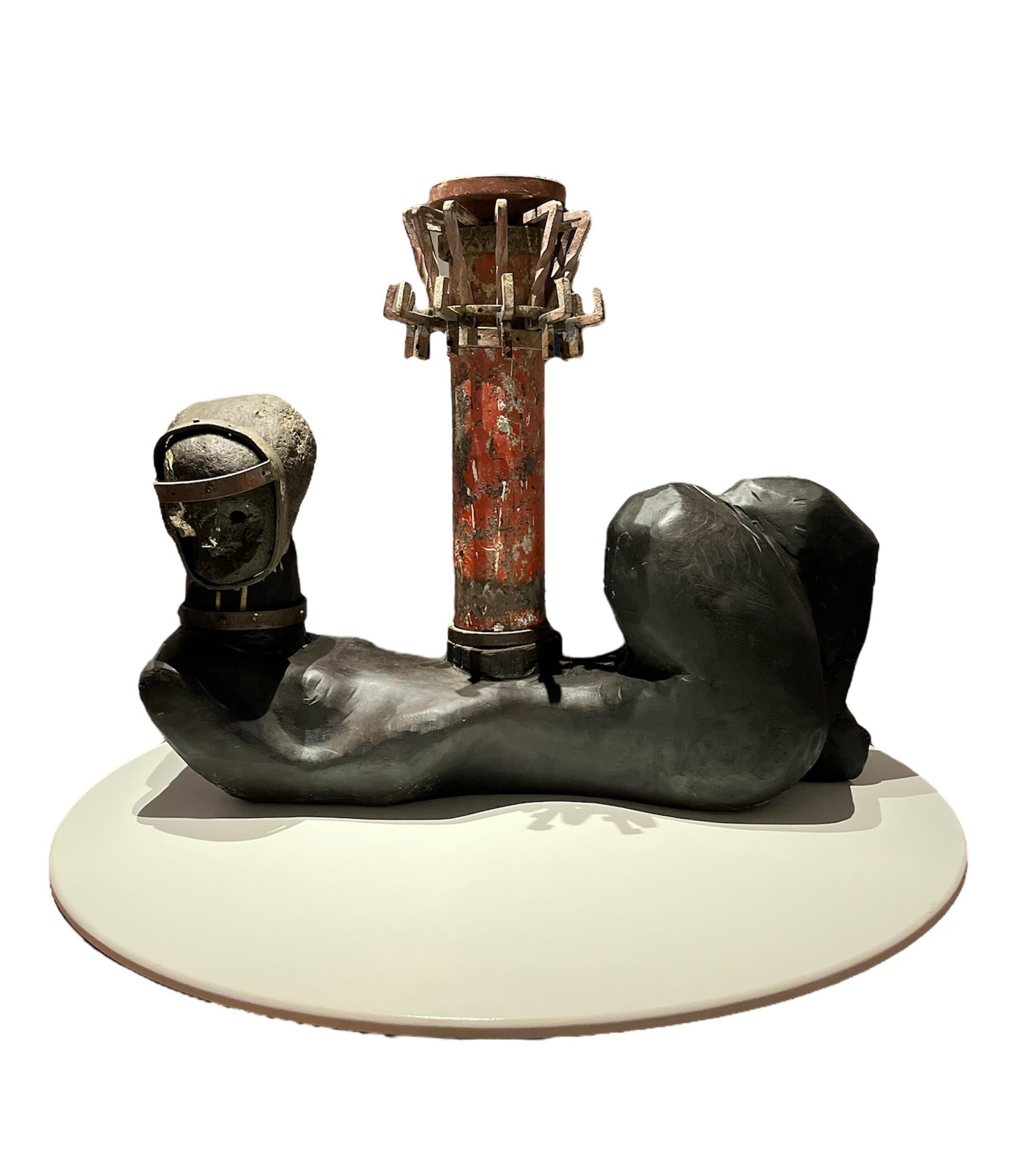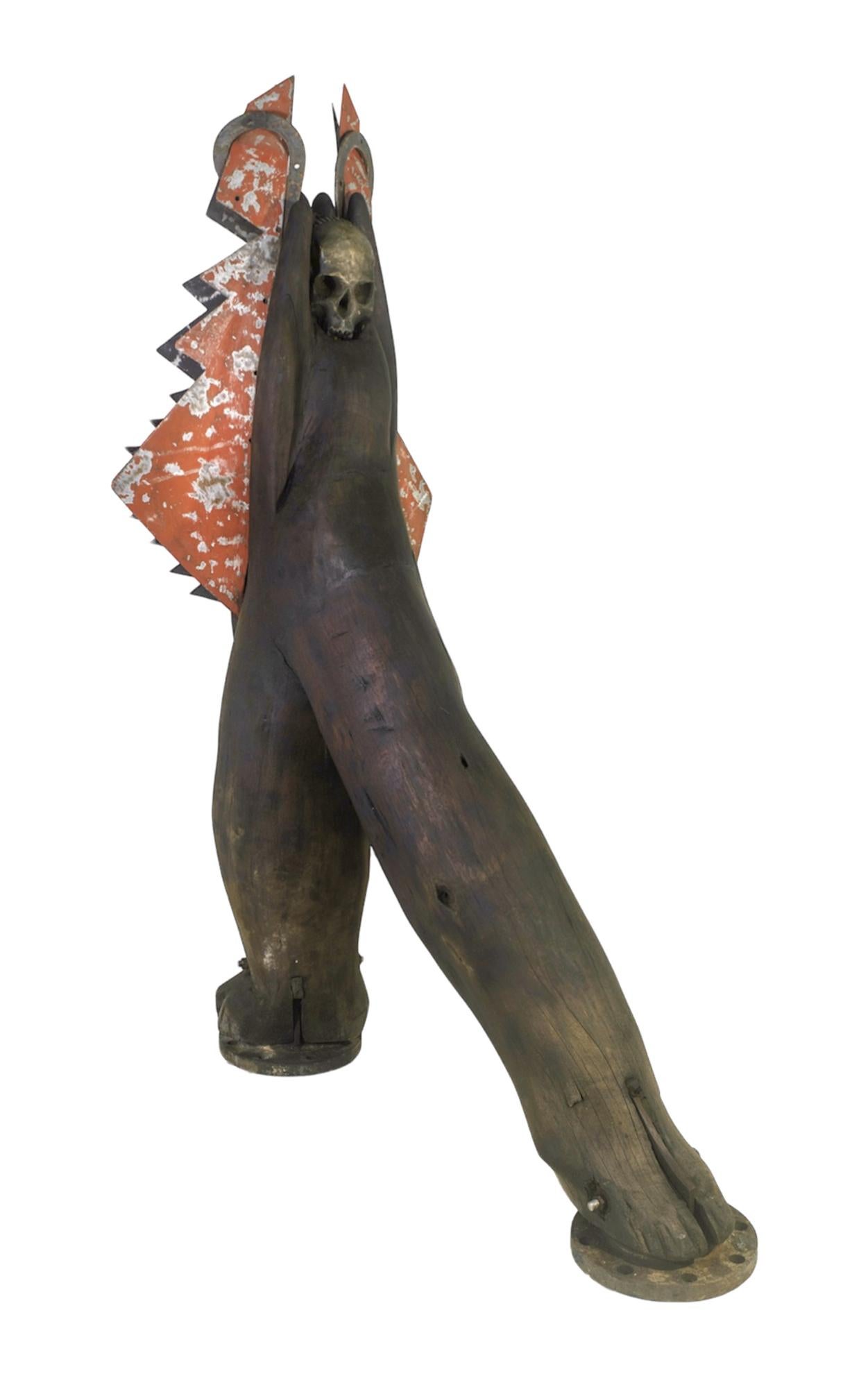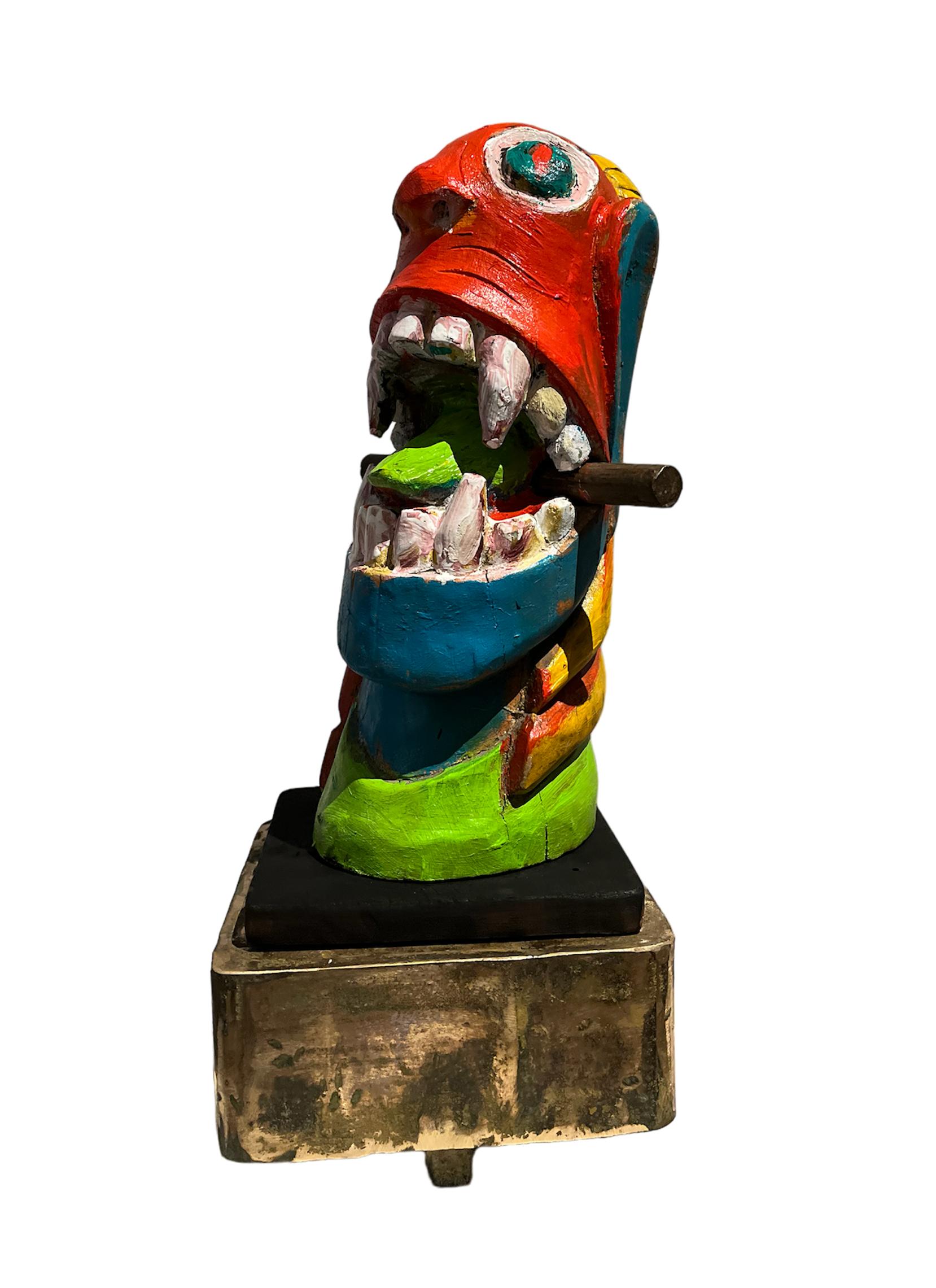Items Similar to Israeli Modernist Arts & Crafts Copper Lion Plaque Bezalel Schatz Yaad Studio
Want more images or videos?
Request additional images or videos from the seller
1 of 10
Israeli Modernist Arts & Crafts Copper Lion Plaque Bezalel Schatz Yaad Studioc.1960s
c.1960s
About the Item
Hand made in israel handwrought tray, platter in Silver plated copper modernist tray, engraving and hammer work, with a whimsical mod lion and design decorations. From the YAAD workshop of Bezalel Schatz, son of Boris Schatz. silver plating has been intentionally rubbed off.
Schatz lived in Israel, New York, and Northern California where he was part of the Big Sur artists'/writers' colony that included San Francisco sculptor Benny Bufano, author Henry Miller, and his sister Zahara Schatz.
Zahara and Bezalel rejected their father's predilection for Romantic Classicism and his dogged development of a Jewish Eretz Israel style in favor of a European-American modernism. Bezalel (nicknamed “Lilik”) Schatz was an Israeli artist, son of Boris Schatz, founder of the Bezalel School of Arts and Crafts in Jerusalem.
Born in 1912 to Boris Schatz, and his wife Olga, an art critic. From an early age, he demonstrated considerable talent for gymnastics and music, but especially for art. He grew up in a home in which artists were a constant presence, he was introduced to Israel’s most prominent leaders, and the first public exhibition of his artwork coincided with his Bar Mitzvah celebration. He attended the Gymnasia in Jerusalem and at age 14 completed his studies at the Bezalel School.
In 1930, Bezalel joined his father on a fundraising tour of Europe and the United States, where they also exhibited their artwork and that of Bezalel students. Following his father’s death in 1932, Bezalel left Israel for a period of about two decades. He spent the first four years studying at the Grand Chaumiere Academy in Paris. There, given the fairly conservative artistic views he had acquired at home and school – where modernism was denounced – he had to pave his own way as an artist among his peers.
Between 1937 and 1951, Bezalel resided in the U.S. Near the end of WWII, he worked in a California shipyard, and it was there he met his future wife, Louise. He was also introduced to the novelist Henry Miller in California, and their friendship blossomed into a creative collaboration. The artist May Ray recorded his observations about the two, noting that “I have never encountered such smooth cooperation…” Bezalel produced silkscreen prints for Miller’s novel, Into the Night Life, an innovation for both the art and publishing worlds. In Florence, New Mexico, New York, San Francisco, and other locations, Bezalel exhibited his own work and participated in group shows with some of the greatest artists of his era – Pablo Picasso, Henri Matisse, Marc Chagall, and Oskar Kokoschka.
Bezalel and Louise married in 1948 and moved to Israel three years later, taking residence in the Schatz house in Jerusalem. Despite his long absence from Israel and his conceptual conflicts with artists there, Bezalel mounted several exhibitions and represented his native country abroad – in Germany and at Venice’s 1954 Biennale, for example. Together with Louise Schatz and his sister, Zahara Schatz, he established the arts and crafts workshop, “Yad.” Handmade modernist folk art objects created there today are displayed and sold in a small building on the grounds of the family home on Bezalel Street in Jerusalem. When the Ein Hod artists’ village was founded in 1953, Bezalel and Louise moved to a home designed for them there by Israeli architect David Reznik. The couple melded easily into the village’s Bohemian artistic life, which resembled the lifestyle they had adopted in California.
Bezalel was an easy-going, congenial man of whom Henry Miller remarked, “Bezalel is an incorrigible optimist, the greatest optimist I ever met.” After his return to Israel, Bezalel’s most pleasurable moments were in the company of his small family and most intimate friends. He also continued to correspond with his friends in the U.S. He refrained from expressing his intellectual insights, either verbally or in writing, and never attempted to justify his work in any way. He was a productive post modernist artist and craftsman – vigorous, sensitive, and curious – and he contributed significantly to Israel’s aesthetic environment and art. His inspiration flowed from many different sources, from primitive tribes, to Biblical tales, Western art, the nature and history of Israel, and the symbols of his homeland that had also inspired his father.
Bezalel’s art work exemplified many different techniques. His early works adhered to the realistic/academic style he learned at the Bezalel art school. Later, his development was influenced by abstract art. His works included sketches, prints, oil painting reliefs, hand made copper engravings, applied art, graphic art, ceramic, and Judaica. In the last decade of his life, his major artistic endeavor was mural design. Among his public works were artwork for ships owned by the Israeli company Zim, the gates at the entrance to the President’s Residence in Jerusalem, and a fence in the courtyard area of the Western Wall.
Bezalel died in Jerusalem in 1978.
- Attributed to:Bezalel Schatz (1912-1983)
- Creation Year:c.1960s
- Dimensions:Height: 7.5 in (19.05 cm)Width: 7.5 in (19.05 cm)
- Medium:
- Movement & Style:
- Period:
- Condition:
- Gallery Location:Surfside, FL
- Reference Number:1stDibs: LU38214258422
About the Seller
4.9
Platinum Seller
These expertly vetted sellers are 1stDibs' most experienced sellers and are rated highest by our customers.
Established in 1995
1stDibs seller since 2014
1,560 sales on 1stDibs
Typical response time: 1 hour
- ShippingRetrieving quote...Ships From: Surfside, FL
- Return PolicyA return for this item may be initiated within 3 days of delivery.
More From This SellerView All
- Mexican Art Abstract Brutalist Biomorphic Bronze Sculpture Mathias GoeritzBy Mathias GoeritzLocated in Surfside, FLMathias Goeritz (German Mexican, 1915-1990) Bronze sculpture Signed and numbered Dimensions: (approximate) Height: 10 inches, Width: 4 inches, Depth: 2 inches. This is a cast bronze sculpture in an amorphous figure shape, quite heavy. Reminiscent of the biomorphic sculpture of Hans Jean Arp. This came from an estate and bears his signature It is not dated. there is no accompanying documentation. it is priced accordingly. Werner Mathias Goeritz Brunner (Danzig, Germany, April 4th, 1915/ now Gdansk, Poland – Mexico City, Mexico; August 4th, 1990). Mathias Goeritz has had several gallery and museum exhibitions, including at the Museo Nacional Centro de Arte Reina Sofía and at the Museo Experimental El Eco. Numerous works by the artist have been sold at auction, including 'MENSAJE' sold at Sotheby's New York 'Latin American Modern Art' in 2015 for $466,000. There have been Several articles about Mathias Goeritz, including 'LACMA remaps Latin America' written by Suzanne Muchnic for the Los Angeles Times. Painter, sculptor and Mexican architect associated with the trend of constructive abstraction. He studied medicine at the University of Berlin, but this only lasted a year. The concerns of the young student were aesthetic in nature so he he studied figurative drawing at the Berlin Charlottenburg School of Art. Some of his friends and colleagues were the sculptor Ernst Barlach, painter George Grosz and draughtsman Kaethe Kollwitz. Goeritz studied philosophy and history of art, discipline in which earned a doctorate. He travelled in France, Switzerland, Czechoslovakia, Poland, Austria and Italy, among other countries. It is known that he left Germany to live in Tetuan, Morocco in 1941 and then Granada, Spain in 1945. In 1946 he had a large exhibition in the Sala Clan in Madrid under the pseudonym "Mago". Two years later, living in Santilla del Mar, Spain he was a founder of the Escuela de Altamira. The following year he married Marianne Gast, writer and his companion for more than fifteen years. In Spain followed his artistic work by important artists of the avant-garde. Of Jewish descent, he found refuge from the Second World War in Mexico where in 1949 he was invited by Ignacio Diaz Morales to be a part of the faculty of the School of Architecture at the Universidad de Jalisco. In 1953 he wrote the "Manifiesto de la Arquitectura Emocional" (The Emotional Architecture Manifesto), where he points out that only achieving true emotions from architecture can it then be considered an art form. In Mexico he entered controversy with the artistic stablishment of that country; in an open letter, Diego Rivera and David Alfaro Siqueiros described him as "an impostor without the most insignificant talent and preparation" to be an artist. Despite this, in 1957 he was elected director of visual design of the National School of architecture This same year he founded the Museo del Eco in Mexico City. In 1961 Goeritz participated at the Galería Antonio Souza in a group exhibition, Los hartos, for which he published another manifesto. Other participants included Jose Luis Cuevas and Pedro Friedeberg, with whom he was instrumental in establishing abstraction and other modern trends in Mexico.His work is included in the Gelman Collection of modern and contemporary Mexican art based in Cuernavaca, Mexico. Established by Jacques and Natasha Gelman in 1943 as a private collection. it includes many iconic works by major Mexican Modernists including Frida Kahlo, Diego Rivera, David Alfaro Siqueiros, Leonora Carrington, Rufino Tamayo and Francisco Toledo, Lola Alvarez...Category
20th Century Modern Abstract Sculptures
MaterialsBronze
- The Test, Assembled Kinetic Modernist Sculpture Puzzle ConstructionBy William King (b.1925)Located in Surfside, FL"The Test," 1970 Aluminum sculpture in 5 parts. Artist's cipher and AP stamped into male figure, front, 20 5/16" x 12 1/2" x 6 5/7" (approx.) American sculptor King is most noted for his long-limbed figurative public art sculptures depicting people engaged in everyday activities such as reading or conversing. He created his busts and figures in a variety of materials, including clay, wood, metal, and textiles. William Dickey King was born in Jacksonville, Florida. As a boy, William made model airplanes and helped his father and older brother build furniture and boats. He came to New York, where he attended the Cooper Union and began selling his early sculptures even before he graduated. He later studied with the sculptor Milton Hebald and traveled to Italy on a Fulbright grant. Mr. King worked in clay, wood, bronze, vinyl, burlap and aluminum. He worked both big and small, from busts and toylike figures to large public art pieces depicting familiar human poses — a seated, cross-legged man reading; a Western couple (he in a cowboy hat, she in a long dress) holding hands; a tall man reaching down to tug along a recalcitrant little boy; a crowd of robotic-looking men walking in lock step. Mr. King’s work often reflected the times, taking on fashions and occasional politics. In the 1960s and 1970s, his work featuring African-American figures (including the activist Angela Davis, with hands cuffed behind her back) evoked his interest in civil rights. But for all its variation, what unified his work was a wry observer’s arched eyebrow, the pointed humor and witty rue of a fatalist. His figurative sculptures, often with long, spidery legs and an outlandishly skewed ratio of torso to appendages, use gestures and posture to suggest attitude and illustrate his own amusement with the unwieldiness of human physical equipment. His subjects included tennis players and gymnasts, dancers and musicians, and he managed to show appreciation of their physical gifts and comic delight at their contortions and costumery. His suit-wearing businessmen often appeared haughty or pompous; his other men could seem timid or perplexed or awkward. Oddly, or perhaps tellingly, he tended to depict women more reverentially, though in his portrayals of couples the fragility and tender comedy inherent in couplehood settled equally on both partners. His first solo exhibit took place in 1954 at the Alan Gallery in New York City. King was elected to the American Academy of Arts and Letters in 2003, and in 2007 the International Sculpture Center honored him with the Lifetime Achievement in Contemporary Sculpture Award. Mr. King’s work is in the collections of the Metropolitan Museum of Art, Guggenheim Museum, Whitney Museum and the Museum of Modern Art in New York and the Hirshorn Museum at the Smithsonian American Art Museum in Washington, among other places, and he had dozens of solo gallery shows in New York and elsewhere. Reviews of his exhibitions frequently began with the caveat that even though the work was funny, it was also serious, displaying superior technical skills, imaginative vision and the bolstering weight of a range of influences, from the ancient Etruscans to American folk art to 20th-century artists including Giacometti, Calder and Elie Nadelman. The New York Times critic Holland Cotter once described Mr. King’s sculpture as “comical-tragical-maniacal,” and “like Giacomettis conceived by John Cheever.”Category
1970s American Modern Figurative Sculptures
MaterialsMetal
- Brutalist Modern Abstract Bronze Sculpture Metropolis Manner of Louise NevelsonBy Abbott PattisonLocated in Surfside, FLA very heavy, massive bronze sculpture by an important Chicago sculptor. Signed and marked "Firenze" with "Fuse Marinelli". METROPOLIS. Seven abstract shapes on black marble base. 1...Category
20th Century Modern Abstract Sculptures
MaterialsMarble, Bronze
- Bronze Architectural Model Sculpture Tempio Bretton Architecture MaquetteLocated in Surfside, FLTEMPIO BRETTON: from the catalogue MONUMENTA, 19th International Sculpture Biennale, Antwerp, Belgium. Tempio Bretton was created in homage to the celebrated English landscapist Capability Brown for the occasion of an exhibition at Bretton Hall in the Yorkshire Sculpture Park , a park in the style of the great master of English garden design. The inclusion in the English garden of a temple ruin, or "eye-catcher," (architectural folly) was used to draw the eye and mind to a focus in time and space, present the beholder with an immediate relationship to an historic past made new within his or her own surroundings, and create a depth of space never before seen in garden design. I took the idea of the temple ruin eye-catcher and reduced it to a scale at the point where architecture and sculpture merged. Tempio Bretton is not capacious enough to walk into, yet it is considerably larger than a man. One view of it presents a knot of golden columns clustered together, topped by a dome shape. The only clue from this side to the temple's non-conformity to historic principle is a sharp notch cut into the square base. Viewed from the opposite side, the cluster of columns capped by an angular top opens up as if to welcome someone in, yet the mysterious core is still impenetrable. These contradictions articulate a confrontation between past and present, and an exciting truth. The past is always at the heart of our constructions in the present. Walter Dusenbery...Category
20th Century American Modern Abstract Sculptures
MaterialsBronze
- Bronze Abstract Space Age Book Sculpture LA California Modernist Charna RickeyBy Charna RickeyLocated in Surfside, FLCharna Rickey 1923 - 2000 Mexican-American Jewish Woman artist. Signed Bronze House of Books, Architecture Bronze sculpture, signed Charna Rickey and on the front "House of the book." It depicts an open Torah. Original patina. Approx. dimensions: 7 in. H x 9 in. W x 8.5 in. D. Weight: 13.1 lbs. Modernist Judaica Sculpture Born Charna Barsky (Charna Ysabel or Isabel Rickey Barsky) in Chihuahua, Mexico, the future artist lived in Hermosillo and immigrated to Los Angeles when she was 11. She was educated at UCLA and Cal State L.A., she married furniture retailer David Rickey and explored art while raising their three daughters. Moving through phases in terra cotta, bronze, marble and aluminum, she found success later in life. Rickey became one of the original art teachers at Everywoman's Village, a pioneering learning center for women established by three housewives in Van Nuys in 1963. She also taught sculpture at the University of Judaism from 1965 to 1981. As Rickey became more successful, her sculptures were exhibited in such venues as Artspace Gallery in Woodland Hills and the Courtyard of Century Plaza Towers as part of a 1989 Sculpture Walk produced by the Los Angeles Arts Council. Her sculptures have also found their way into the private collections of such celebrities as Sharon Stone. Another of Rickey's international creations originally stood at Santa Monica College. In 1985, her 12-foot-high musical sculpture shaped like the Hebrew letter "shin" was moved to the Rubin Academy of Music and Dance at Hebrew University in Jerusalem. The free standing architectural Judaic aluminum work has strings that vibrate in the wind to produce sounds. Rickey also created art pieces for the city of Brea. They commissioned some amazing art pieces by Laddie John Dill, Walter Dusenbery, Woods Davy, Rod Kagan, Pol Bury, Niki de Saint Phalle, Magdalena Abakanowicz, Larry Bell, John Okulick...Category
20th Century American Modern Abstract Sculptures
MaterialsMarble, Bronze
- Cast Bronze Organic Husk Wall Mounted Abstract Textured Sculpture Seena DonnesonBy Seena DonnesonLocated in Surfside, FLThis is an abstract Flora based hand made, cast sculpture done by Seena Donneson an acclaimed woman artist. A textured abstract bronze with deep, rich patina; The sculpture is signed...Category
21st Century and Contemporary Modern Abstract Sculptures
MaterialsBronze
You May Also Like
- Orí Yucateca, Figurative Sculpture. From the Series SculpturesLocated in Miami Beach, FLOrí Yucateca, 2015 - 2024 by José Ignacio Suarez Solis From the Series Sculptures Carving, assembling and painting (granite, wood, iron, acrylic, zinc plate and copper wire) Size: 19...Category
2010s Abstract Abstract Sculptures
MaterialsGranite, Copper, Iron, Wire
- ORÍ GUERREIRA NA LUZ I, Figurative Sculpture. From the Series SculpturesLocated in Miami Beach, FLORÍ GUERREIRA NA LUZ I, 2021 - 2023 by José Ignacio Suarez Solis From the Series Sculptures Carving, assembling and painting (granite, wood, iron, acrylic, zinc plate and copper wire...Category
2010s Abstract Abstract Sculptures
MaterialsGranite, Copper, Iron, Wire
- ORÍ GUERREIRA NA LUZ II, Figurative Sculpture. From the Series SculpturesLocated in Miami Beach, FLORÍ GUERREIRA NA LUZ II, 2021 - 2023 by José Ignacio Suarez Solis From the Series Sculptures Carving, assembling and painting (granite, wood, iron, acrylic, zinc plate and copper wir...Category
2010s Abstract Abstract Sculptures
MaterialsGranite, Copper, Iron, Wire
- ORÍ GUERREIRA TUPINANDACARU I, Figurative Sculpture. From the Series SculpturesLocated in Miami Beach, FLORÍ GUERREIRA TUPINANDACARU I, 2018 - 2023 by José Ignacio Suarez Solis From the Series Sculptures Carving, assembling and painting (granite, wood, iron, acrylic, zinc plate and copp...Category
2010s Abstract Abstract Sculptures
MaterialsGranite, Copper, Iron, Wire
- Apropriaçao frei de carranca, Figurative Sculpture. From the Series SculpturesLocated in Miami Beach, FLApropriaçao frei de carranca, 2023 by José Ignacio Suarez Solis From the Series Sculptures Carving, assembling and painting (granite, wood, iron, acrylic, zinc plate and copper wire)...Category
2010s Abstract Figurative Sculptures
MaterialsGranite, Copper, Iron, Wire
- ALMIRAMAYA, Figurative Sculpture. From the Series SculpturesLocated in Miami Beach, FLALMIRAMAYA, 2022 - 2023 by José Ignacio Suarez Solis From the Series Sculptures Carving, assembling and painting (granite, wood, iron, acrylic, zinc plate and copper wire) Size: 75 H...Category
2010s Abstract Figurative Sculptures
MaterialsGranite, Copper, Iron, Wire





